Joy Neal Kidney's Blog, page 47
November 2, 2022
Clabe Wilson saved a clipping called “Why Is Gossip Harmful?”
“The fear of the tongue,” Willa Cather wrote, “that terror of little towns. . . .”
Clabe Wilson knew about it first hand.
Railroad officials had asked around Dexter about anyone seen spending time along the railway. It looked like something had been deliberately placed on the tracks to hinder the trains. Clabe Wilson’s name came up and he was questioned about it. He occasionally drank to meanness, but was honest to a fault, sometimes to his own detriment.
But the suspicion stung.
New Year’s Day 1935, Clabe trudged along the Rock Island tracks, shivering as he headed to the pumphouse, a part-time WPA job, brooding about being suspected of a misdeed. Was it common gossip around Dexter that he couldn’t find a real job? That he sometimes drank too much? Drab smoke drifted from chimneys into the weary winter as he plodded by each house. It was desolate and cold inside the little brick pumphouse, with nothing to do but keep the pump oiled.
Being on welfare in the 1930s was called being “on the dole” or “on relief.” Families were ashamed to accept money and food paid for by other citizens. The Wilsons were in that somber predicament.
Neighbors and teachers in this small town were appreciative and supportive of the family, but a few negative comments wormed their way back. Not only that but accepting government dole was a dreaded necessity.
Clabe tucked a June 16, 1935, clipping into a small cloth-covered New Testament, “Why Is Gossip Harmful?” At the bottom he wrote in pencil “Look it up.” The Scripture noted was James 3:1-6, about the destruction the tongue can wage.
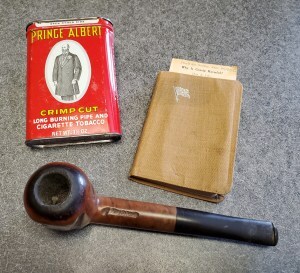 Prince Albert was Clabe’s choice for pipe tobacco. This is his pipe and the small New Testament with the clipping still between the pages, “Why Is Gossip Harmful?”
Prince Albert was Clabe’s choice for pipe tobacco. This is his pipe and the small New Testament with the clipping still between the pages, “Why Is Gossip Harmful?”There are several paragraphs, but Clabe had underlined part of this one: “A gossip is a public menace, and richly deserves to be muzzled; for a biting, dishonest human tongue can do more harm than the snapping jaws of a dog! A gossip can ruin your reputation, start a run on a bank, break up a church, make neighbors hate one another, shatter the happiness of a town. And no man is immune to the serpentlike flashing of a gossip’s tongue.”
Keeping a clipping like that says a lot about a man.
—–
This became part of a chapter called “Gossip” in Leora’s Dexter Stories: The Scarcity Years of the Great Depression.
October 31, 2022
“Doing History” by Reading Minds by Dennis Peterson
by Dennis Peterson
Often, I’ve regretted not having access to a plethora of private documents–letters, journals, photos, etc.–on which to base my study of and writing about my family’s history. Unlike Joy Neal Kidney, who has uncovered scads of such documents for the basis of her three books (to date, with another in the works).
Sometimes, however, we can fail to see the forest for the trees. We can fail to see the obvious right under our nose.
This fact suddenly occurred to me several weeks ago as I was engaged in my daily Bible reading. I was using a Bible that I had given as a Christmas gift to my parents while I was a student in college. My mother had written her name at the top of the first page, but it was Daddy’s infrequent underlinings of verses and his scribbled notes in the margin that attracted my attention.

Daddy was a laboring man, a brick mason, and he had large, rough, calloused hands. His handwriting never came close to resembling the Palmer or Zaner-Bloser styles taught when he was in school. Unlike my mother’s neat, always legible handwriting. Even her hurriedly jotted grocery and to-do lists were the epitome of handwriting correctness. Daddy’s handwriting, on the other had, was seldom neat, even when he concentrated on it. It was, at best, a scrawl.
But whenever I encountered his underlining or writing in the margin of that Bible, I began to go back and reread the verse or passage or read his notations, trying to determine what he was thinking at the moment he read the verse or passage. I began asking myself questions. (Much of “doing good history” involves asking good questions.)
What prompted that particular verse or passage to strike a chord for him at that moment?What was happening–or had happened–to give it special meaning for him?Why did he write that particular note? What–or who–was influencing his thinking at that moment?Daddy didn’t keep a journal. He wasn’t a writer. So I have nothing by which I can reach definitive answers to such questions. But if I know certain other facts, I often can surmise answers that might help me better understand him and his thinking at the moment he underlined or wrote a cryptic note in the margin.
Consider, for example, this one instance. When he was reading Psalm 37, he underlined verses 1 and 7 out of the total of 40 verses in the psalm. Why had those specific verses captured his attention so clearly as to prompt him to underline them?
By the way, I knew that Daddy, not Mother or anyone else, had underlined those verses because he had a “style” of underlining unique to himself. He didn’t underline a whole unbroken line of text; his underlining was erratic. He would underline perhaps the first word, leave a gap, underline the next two words, then leave a gap, skip a word, underline one or two more, etc. It was unpredictable and seemingly random. Sometimes, even only part of a word would be underlined.
But I digress.
Both verses say “fret not.” Don’t worry. Don’t let yourself get all wrought up. About what?
“Because of evil doers . . . those who work unrighteousness” (v. 1).
“Because of him who prospers in his way . . . who brings evil devices to pass” (v. 7).
Now what motivated Daddy to focus on those particular verses?
On a December Sunday night, about a week before Christmas, Daddy, Mother, and Gina, my sister, were on their way to the evening church service for the Christmas cantata. My parents were in the choir. My sister possibly was playing the piano or the organ. They were all anticipating a joyous Christmas holiday together.
As they topped a hill, a car coming the opposite direction hit them head on. Mother was thrown into the windshield. She died a few days later. Daddy, on the passenger side, and Gina, who was driving, were injured. Gina returned to college (at Daddy’s insistence) after the first of the year to graduate, but Daddy remained in the hospital for several weeks and then, even after being released, was unable to return to work for months.
The driver of the other car had been drinking and had a blood alcohol count far above the legal limit. He was not seriously injured. He was never charged. Neither the sheriff nor the detectives in his office pursued an investigation. A judge refused to issue an arrest warrant for the drunk driver. Justice was never executed. Everyone involved seemed to go about their lives as normal, not in the least affected by their actions–or inaction. Except Daddy.
Naturally, Daddy was dismayed by this miscarriage of justice. He lobbied numerous public officials at many levels, begging them to do their jobs or to encourage others to do what they were pledged by oath to do in their positions, and to bring justice to bear–and to gain closure for him. But no one did anything.
Daddy had a “right” to worry and be angry, right?
He was. But one day, he read those verses in Psalm 37 and apparently made the choice to stop fretting and just to leave the matter in God’s hands.
In the end, over time, justice was served. Not in the way Daddy expected and wanted, but in God’s way and in His time.
The drunk driver, apparently unable to deal with his guilt, committed suicide. The detective who refused to investigate and the judge who refused to issue a warrant were removed from their positions. The sheriff was himself later arrested, convicted, and imprisoned for operating a “chop shop,” dealing in stolen cars. He was replaced by a new sheriff who had campaigned primarily on getting tough on drunk drivers.
All of this without any action–or fretting–by Daddy.
Perhaps these things were in Daddy’s mind when he read those verses. They taught him to “let go and let God.”
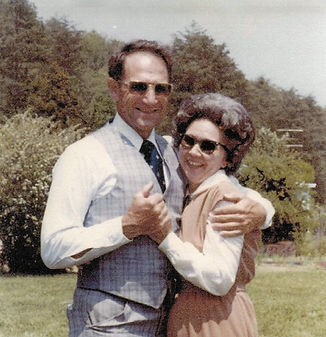
I had to do the same kind of “mind reading” when I was trying to determine why Daddy dropped out of Lincoln Memorial University before he ever recorded a grade on his transcript. Lack of money? Academic problems? The need for him, an only son, to work on his father’s dairy farm? Homesickness for the love of his life, his future bride and my future mother?
In doing your own research, especially if you don’t have written records, try to ask questions about what motivated your subjects’ actions. What were they thinking? What influences affected their actions? In effect, try to read their minds and come up with plausible back stories to round out your family history.
—–
 Dennis L. Peterson is a historian and the author of several books, including the delightful Look Unto the Hills: Stories of Growing Up in Rural East Tennessee. He is also a regular contributor to Our American Stories.
Dennis L. Peterson is a historian and the author of several books, including the delightful Look Unto the Hills: Stories of Growing Up in Rural East Tennessee. He is also a regular contributor to Our American Stories.
Website for Dennis Peterson. At the top of the home page are his delightful audio stories, ready to listen to.
Here’s his Amazon Author Page.
October 28, 2022
Book Talk in Guthrie Center November 1
 4 p.m., November 1, 2022, Mary J. Barnett Memorial Library, Guthrie Center, Iowa
4 p.m., November 1, 2022, Mary J. Barnett Memorial Library, Guthrie Center, Iowa
 Cover photo taken in 1914 in front of the home of Clabe Wilson’s mother. Newlyweds Clabe and Leora Wilson
Cover photo taken in 1914 in front of the home of Clabe Wilson’s mother. Newlyweds Clabe and Leora WilsonLeora’s Early Years: Guthrie County Roots, Joy Neal Kidney new release
Short Description: The oldest of 10 children, Leora Goff developed the tenacity, optimism, and hope to endure many family moves, great losses, an influenza pandemic, brothers sent off to the Great War, marriage to Clabe Wilson, and the births of seven children–mostly set in Guthrie County.
After World War II, she was a long-time resident of Guthrie Center, a Gold-Star Mother active in her church and many civic groups.
“Morrisburg Cemetery,” a poem by Guthrie Center native Nicholas Dowd, enhances the book. (Clabe Wilson’s mother and grandparents are buried in Morrisburg Cemetery, along with several other relatives.)
Joy’s other books are Leora’s Letters: The Story of Love and Loss for an Iowa Family During World War II and Leora’s Dexter Stories: The Scarcity Years of the Great Depression. All five Wilson brothers are remembered on the Dallas County Freedom Rock at Minburn, near where they were tenant farmers during the war. Only two came home.
Guthrie Center, Iowa, was Grandma Leora Wilson’s town, where she made a home for her own mother after WWII until Great Grandmother Laura Arminta (Jordan) Goff died in 1962. Grandma lived alone for the first time in her long life until the age of 97, in 1987. Guthrie Center meant Grandma Leora for us, a half-an-hour drive from rural Dexter.
I still have a soft spot for Guthrie Center, enjoying Sunday dinner at the Cabbage Rose Restaurant on a Sunday, after driving there from the Des Moines area, “over the river and through the woods” (Monteith, where Clabe and Leora met and began their married life, also where Leora’s mother was born in a log cabin in 1868).
Grandma Leora lived at 505 N. 4th Street, now remodeled and unrecognizable as Grandma’s little house.
Come hear stories about early Guthrie County!
October 24, 2022
Prairie College Country School and first “Talking Machine”
Prairie College Country S chool
Sherd and Laura Goff moved about 1898 to a farm south of Guthrie Center, along a hilly dirt road that was later hard surfaced and named Highway 25. They moved the pioneer house built in 1855 by Laura Goff’s grandfather, Ephraim Moore, and remodeled it. Their oldest daughter Leora was seven then and walked with three siblings about ¾ mile to her country school called “Prairie College.”
Officially Valley No. 7, it was there she heard her first “talking machine.” The rest of the family was too tired to go, so they let her take their little dog Fanny. Her father told her that Fanny would take care of her.
Fanny wasn’t allowed in the house, but she followed Leora right into the schoolhouse and stayed at her feet under a desk. In her memoirs, Leora remembered that several people came and they had to take turns using earphones, so her turn to listen seemed so short. Leora “wasn’t a bit afraid” walking home in the moonlight with Fanny.
Decades later my mother and I used Leora’s memoirs for clues, searching for the places where her stories may have taken place. We traveled along Highway 25, turning off onto a gravel road to get our bearings, and surmising where the house might have been–back when her brother Rolla was born, and when she heard her first talking machine.
Along the road near the highway was a ditch full of glowing lilies–a common remembrance of where a country school used to sit. We think we may have found where Guthrie County’s “Prairie College” was, so the old Moore/Goff house must have been near there.
 Prairie College school, 6 miles south of Guthrie Center, Iowa, about 1898. Back: Milly Moore, Forest Crawley, Mable France, Mattie Eweing, Bessie Crawley, Carl Crawley, Elsie France, Etta Moore. Front: Verna Davis, Ida Moore, Isaac Moore, Lonnie Crawley, teacher Clara Davis Olmsted (a student of Laura Jordan at one time), Guy Olmstead, Luella France, Ray Eweing, Leora Goff. Seated: Wayne Goff, Merl Goff. Kids are barefooted.
Prairie College school, 6 miles south of Guthrie Center, Iowa, about 1898. Back: Milly Moore, Forest Crawley, Mable France, Mattie Eweing, Bessie Crawley, Carl Crawley, Elsie France, Etta Moore. Front: Verna Davis, Ida Moore, Isaac Moore, Lonnie Crawley, teacher Clara Davis Olmsted (a student of Laura Jordan at one time), Guy Olmstead, Luella France, Ray Eweing, Leora Goff. Seated: Wayne Goff, Merl Goff. Kids are barefooted.Leora’s Early Years: Guthrie County Roots has more about attending Prairie College School.
October 22, 2022
Max & Amy interview on WHO-Radio
If you’d like to listen to the interview.

October 21, 2022
Review of “Leora’s Early Years” by Author Dennis Peterson
Genealogies can sometimes seem boring, especially if you don’t know the families whose lineages are being charted. Sometimes even that of one’s own family can be tedious and interminable. Even the Bible refers to “endless genealogies” (1 Tim. 1:4).
But hidden among such genealogies, begging to be discovered, are fascinating and inspiring stories awaiting a storyteller to share them. That also is the case with the genealogies in the Bible. And, thanks to the Holy Spirit-inspired writers of that sacred text, we have the accounts of many of those “heroes of the faith” to profit from today.
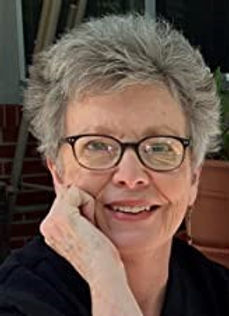
Joy Neal Kidney is the self-styled keeper of her family’s stories. She has realized the value and importance of not only preserving but also sharing those stories so that even strangers to her family can enjoy them and get to know the subjects as though they were part of their own families. The result is three volumes, each going deeper into her family’s history.
The first book was Leora’s Letters: The Story of Love and Loss for an Iowa Family During World War II, which tells of five members of her family who served our country during World War II. Three of them never came home. Her story is of a family that made the ultimate sacrifice–times three.
Next came Leora’s Dexter Stories: The Scarcity Years of the Great Depression, which recounts the family’s perseverance through the trials of that difficult time. The family was again making sacrifices, economically that time. Making do. Doing without. Without complaint.

Now Joy has reached even deeper into the well of her family history and pulled up still more stories that define and describe the roots of the family’s character and resilience. These are the stories that explain why the family could survive–even thrive–through the deprivation of the Depression years and deal with the losses of war. Leora’s Early Years: Guthrie County Roots traces the family saga from 1892 to 1926. In this installment of the larger story, one finds the Wilson family, so prominently featured in the two previous books, merging with the Goffs.
The stories in this book have often been compared to those told in the books of Laura Ingalls Wilder. Indians. Pioneer settlers. Drought and dust storms. Disease. Murder. Death in so many ways.
But it also tells of happier and less trying times, such as circuses, school activities, sledding, state fairs, weddings, and the myriad joys of agrarian life.
The stories are short, quick reads presented by a master storyteller. More importantly, however, they are interesting. Although readers might not know the people about whom they are reading, they don’t have to. Besides, by the time they’ve finished reading this book, they’ll feel as though they know the entire family.
Perhaps the greatest endorsement this book could have received is that of Lee Habeeb, the founder and host of the Our American Stories radio program. Habeeb knows good stories when he sees them, and he thought that those told in Joy Neal Kidney’s books are so good that he awarded her the first Great American Storyteller Award–and then named the annual award in her honor. Kidney is a regular contributor to Habeeb’s program. Habeeb also wrote the foreword to Leora’s Early Years because he enjoyed Kidney’s stories so much.
I think you’ll enjoy them, too!
Read more about Joy and her writings at joynealkidney.com or listen to them at ouramericanstories.com .
—–
 Dennis L. Peterson is a historian and the author of several books, including the delightful Look Unto the Hills: Stories of Growing Up in Rural East Tennessee. He is also a regular contributor to Our American Stories.
Dennis L. Peterson is a historian and the author of several books, including the delightful Look Unto the Hills: Stories of Growing Up in Rural East Tennessee. He is also a regular contributor to Our American Stories.
Website for Dennis Peterson. At the top of the home page are his delightful audio stories, ready to listen to.
Here’s his Amazon Author Page.
October 19, 2022
Smorgasbord Bookshelf: New Book on the Shelves by Sally Cronin
 Smorgasbord Bookshelf – New Book on the Shelves – #History #Family Leora’s Early Years: Guthrie County Roots (Leora’s Stories) by Joy Neal KidneyPosted on October 19, 2022
Smorgasbord Bookshelf – New Book on the Shelves – #History #Family Leora’s Early Years: Guthrie County Roots (Leora’s Stories) by Joy Neal KidneyPosted on October 19, 2022

Delighted to share the news of the latest release by Joy Neal Kidney – Leora’s Early Years: Guthrie County Roots (Leora’s Stories) – I recently read and enjoyed Leora’s Letters so I am sure this book will be a delight to read.

About the book
During Leora Goff’s early decades, she gathered the tenacity, optimism and hope she would need throughout her long life. When she married Clabe Wilson, they became forged into parents who would shepherd their own family through two more great eras of world and local history–the Great Depression and WWII.
Head over to buy the book: Amazon US – and: Amazon UK
Also by Joy Neal Kidney
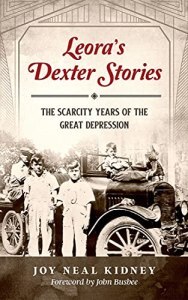
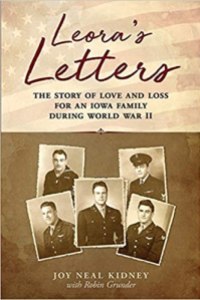
My review for Leora’s Letters August 6th 2022
This book is an intimate inclusion in one family’s life and loss during the Second World War. Clabe and Leora work tirelessly on the farm they manage to raise their children and put something by for their dream of owning their own farm. In this rural environment it is natural for young men and women to perhap have their own dreams and even before Pearl Harbour one son has signed up with the Navy. Over the course of the war five sons would enlist to serve their country.
Through the letters written by Leora to her sons, and their often censored letters in return we share life on the home front and also their challenges as they go through training and then deployment. Their only link to home is these letters and others between each other and their sisters, and it is clear that this is a close knit and loving family doing their best through a very difficult time.
One can only imagine the constant worry any parent would have with a child serving on the front line, particularly with incomplete news reports in the media, long after major battles at sea and in the air. But to have five sons in the line of fire in the Pacific and in Europe must have been unbearable.
The letters are beautiful in their simplicity and informality as they would have been between a loving family. There is also some wry humour as the boys encounter the world outside their rural upbringing and undergo their training, as well as a deep love of their parents as they send money home toward their dream of owning their own land.
From the first page we are drawn into this family and feel the hope, love and loss they suffer over the course of the war. Whilst there is sadness, there is also admiration for a brave mother and her sons who believed in doing their duty, and respect for the sacrifice this family made. War should never be glorified, but those who lay their lives on the line for their country should be, especially when young with their whole lives ahead of them.
This period for all of us is now moving from living history as the last of those who can share their stories pass away. It is so important that major events such as major conflicts are fought by ordinary men and women and their stories deserve to be told and remembered.
The author has done a wonderful job in collating these letters that recreate so vividly this time in world histry. By doing so she honours the members of her family, including her own parents who lived, loved and lost so much.
Read the reviews and buy the books: Amazon US – And: Amazon UK – More reviews: Goodreads – Website: Joy Neal Kidney – Facebook: Joy Neal Kidney Author – Twitter: @JoyNealKidney – Instagram: Joy Neal Kidney

About Joy Neal Kidney
Joy Neal Kidney is an Iowa author who grew up on a farm, now living in a Des Moines suburb with her husband, Guy, an Air Force Veteran of the Vietnam War and a retired Air Traffic Controller. Their son is married and they live out-of-state with a small daughter named Kate.
With God’s help, Joy is aging gratefully. Living with fibromyalgia for two dozen years has given her plenty of home-bound days to write blog posts and books. “Leora’s Early Years: Guthrie County Roots” is her third book in the “Leora Stories” series. Her research from decades ago has helped tell her grandmother’s stories.
She was presented with the 2021 Great American Storyteller Award “Honoring the woman who most beautifully tells the story of America to Americans,” by Our American Stories and WHO NewsRadio 1040.
Thanks for dropping in today and I hope you will be leaving with some books.. thanks Sally.
October 17, 2022
Public Sale, Guthrie County, Iowa, 1905
Daniel R. Wilson was the father of Clabe Wilson. This was in 1905, so Clabe would have been 17 years old. The year before, the local newspaper noted that Dan Wilson had been a “very sick man.” Did that lead to his having a sale in October?
—–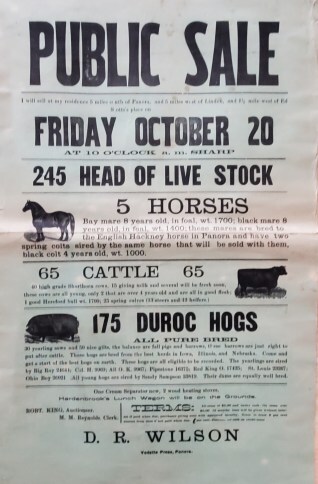
I will sell at my residence 5 miles south of Panora, and 5 miles west of Linden, and 1 1/2 mile west of Ed Stott’s place on
FRIDAY OCTOBER 20 [1905]
at 10 O’CLOCK a.m. SHARP
245 HEAD OF LIVESTOCK
5 HORSES
Bay mare 8 years old, in foal, wt. 1700; black mare 8 years old, in foal, wt. 1400; these mares are bred to the English Hackney horse in Panora and have two spring colts sired by the same horse that will be sold with them, black colt 4 years old, wt. 1000
65 CATTLE 65
40 high grade Shorthorn cows, 15 giving milk and several will be fresh soon, these cows are all young, only 2 that are over 4 years old and are all in good flesh; 1 good Hereford bull wt. 1700; 25 spring claves (13 steers and 12 heifers.)
175 DUROC HOGS
ALL PURE BRED
30 yearling sows and 50 nice gilts, the balance are fall pigs and barrows, these barrows are just right to put after cattle. These hogs are bred from the best herds in Iowa, Illinois, and Nebraska. Come and get a start of the best hogs on earth. These hogs are all eligible to be recorded. The yearlings are sired by Big Roy 24644; Col. H. 9969; All O.K. 9967; Pipestone 16375; Red King O. 17425; St. Louis 23267; Ohio Boy 26021. All young hogs are sired by Sandy Sampson 33819. Their dams are equally well bred.
One Cream Separator new, 2 wood heating stoves.
Hardenbrook’s Lunch Wagon will be on the Grounds.
ROBT. KING, Auctioneer. M. M. Reynolds, Clerk,
TERMS: All sums of $5.00 and under cash On sums over $5.00 12 months time will be given without interest if paid when due, purchaser giving note with approved security. Notes to draw 8 per cent interest from date if not paid when due. 6 per cent. discount for cash on credit sums
D. R. WILSON
Vedette Press, Panora.
But the next year, Dan Wilson was in the Duroc Jersey hog business again. He bought LaFollett, “an aristocratic fellow” with a fancy pedigree.
Dan Wilson died at the Clarinda State Hospital just four years later. He’d thrown a corn knife at Clabe, who’d diapered his baby sister (born in early 1907), so there was chaos at home. I’ve tried to understand the circumstances, with only a few details.October 14, 2022
Lee Habeeb, founder and host of Our American Stories
I am so grateful to Lee Habeeb, who is the founder and host of Our American Stories, a talk radio executive, and Newsweek essayist. When asked if he would write the foreword for Leora’s Early Years, this very busy man said he’d happy to! When he asked how long I’d like it, I wasn’t fond of long ones so I suggested one page.
The very next day, I happily read one four pages long, so I quickly sent Lee a note saying to write whatever he felt led to write. The foreword is longer than any of the chapters, but I’m so thankful this busy man took the time to enhance the book.
I’ve recorded more than a dozen stories for Our American stories during the past three years. When you listen to the program, Lee introduces each story and makes a comment at the end.

Locally they are aired week nights over WHO-NEWSRADIO 1040 am. They are also podcast through iHeart and Spotify. Recently Lee Habeeb was ranked #12 in Talker Magazine‘s “Heavy Hundred,” a subjective power ranking of the nation’s talk radio hosts.
Lee Habeeb is also a University of Virginia Law School graduate and lives in beautiful Oxford, Mississippi, with his wife Valerie, daughter Reagan, two pugs (Leroy Jenkins and Bubba), two cats (Spunky and Mario) and twelve chickens.
—–
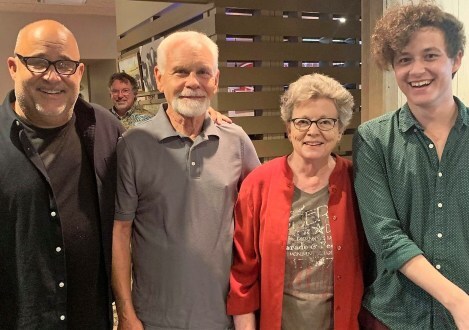 Lee Habeeb, (photobomber Kurt Bowermaster), Guy, Me, OAS producer Matt “Montie” Montgomery. Our Iowa Stories night at the Urbandale Machine Shed, July 2021
Lee Habeeb, (photobomber Kurt Bowermaster), Guy, Me, OAS producer Matt “Montie” Montgomery. Our Iowa Stories night at the Urbandale Machine Shed, July 2021Here’s Lee’s 12-minute story about his mother.
His 12-minute story about three key elements in his early life that changed and shaped his life.
Leora’s Early Years: Guthrie County Roots
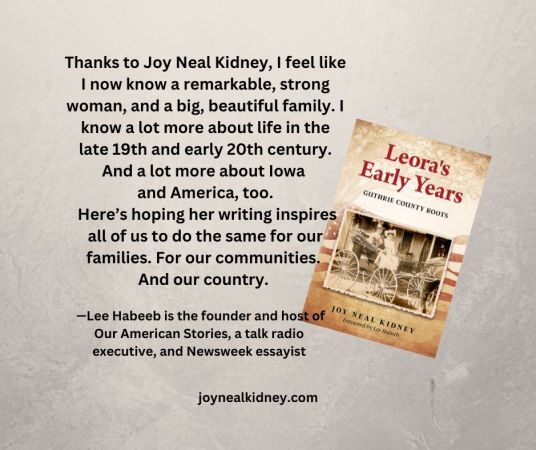
October 12, 2022
October is National Family History Month
What if something you wrote became a treasure for your grandchildren?
That’s what happened for me. Years ago, I’d asked Grandma Leora Wilson to write her life’s story and she did, by hand on typing paper over several years.
What stories she told–about Indians trading dress goods for chickens (and laughing at her father’s mules), about moving to northern Minnesota on a train (with everyone sick and arriving in a blizzard), attending sewing school at Exira (1910, when Comet Halley was visible), a Chautauqua date at Panora with Clabe Wilson, marriage and the births of ten children children, suffering through the influenza pandemic, the scarcity years of the Great Depression, all nine children with whooping cough and, the World War II years, when she and Clabe lost three of their five sons who served.
 Grandma Leora’s daughters discovered what she’d written after her death in 1987. I transcribed those memoirs, added old photos, and made copies for all the relatives. This is still a treasure for all of us.
Grandma Leora’s daughters discovered what she’d written after her death in 1987. I transcribed those memoirs, added old photos, and made copies for all the relatives. This is still a treasure for all of us.
How about starting your own memoirs during National Family History Month? In 2001, Congress first passed a resolution, introduced by Sen. Orrin Hatch of Utah, who wrote, “By searching for our roots, we come closer together as a human family.” Since then, Family History Month has been observed annually during the month of October.
Ask the oldest ones in your family to write what they remember. One memory will open the door and lead to others. Talking about them will stir up even more memories. Older family members not only hold valuable stories, they are benefited by perspective.
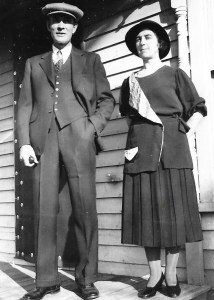 Don’t forget to look through old photos and make sure they’re labeled. Ask questions about them. One surprise I ran into was taking for granted that my grandparents were all dressed up for a special occasion in an early 1935 photo. I asked Mom whether they might be going to a wedding. No, they were waiting for a ride so her mother could have the eye of a needle taken out of her hand.
Don’t forget to look through old photos and make sure they’re labeled. Ask questions about them. One surprise I ran into was taking for granted that my grandparents were all dressed up for a special occasion in an early 1935 photo. I asked Mom whether they might be going to a wedding. No, they were waiting for a ride so her mother could have the eye of a needle taken out of her hand.
Why would they dress up for that? Because their only other clothes were overalls and a housedress. This was during the Great Depression. They had no car at that point, not until sometime in 1939.
That one photo led to stories about the Depression, hauling water, doing the washing for a family of nine on a washboard (because her hand-worked washing machine was broken), the doctor having trouble finding the needle, his worrying that winter weather and using ether as an anesthetic could lead to pneumonia. All from one small photograph.
Share growing up stories, what you remember of your grandparents. Details. Your faith story. Holiday and school stories.
Perhaps stories from your past, ones that you might consider commonplace, will one day be among a grandchild’s treasured keepsakes.
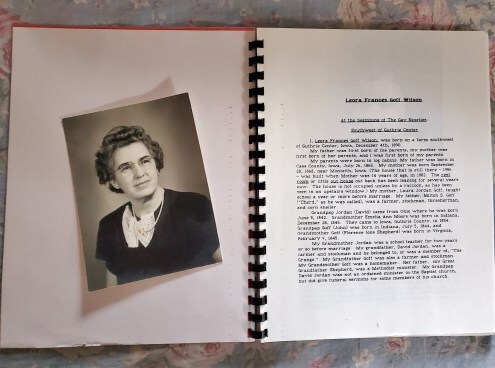 Typed up on a Mac Plus computer, printed on a dot-matrix printer, and distributed to relatives in 1990
Typed up on a Mac Plus computer, printed on a dot-matrix printer, and distributed to relatives in 1990Grandma’s memoir became the scaffolding for the three books about her long life, at least through the first six decades. This Amazon Author Page link will take you to all three.



